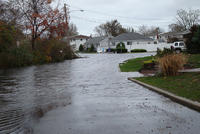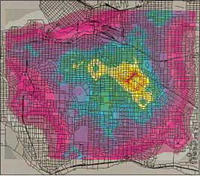-
Thousands at risk from dirty syringes used in clinics, hospitals

U.S. health officials are still fighting a battle which was supposed to be over more than fifty years ago: dirty needles (the disposable syringe became widely available in the early 1960s); in the last eleven years, more than 150,000 patients nationwide were victims of unsafe injections, and two-thirds of those injections have been administered since 2008
-
-
Hydrogen peroxide vapor kill superbugs dead
Infection control experts at the Johns Hopkins Hospital have found that a combination of robot-like devices that disperse a bleaching agent into the air and then detoxify the disinfecting chemical are highly effective at killing and preventing the spread of multiple-drug-resistant bacteria, or so-called hospital superbugs
-
-
The burden of disease links ecology to economic development and growth
According to conventional economic wisdom, the foundation of economic growth is in political and economic institutions; researchers argue that, in fact, vector-borne and parasitic diseases have substantial effects on economic development across the globe, and that these diseases are major drivers of differences in income between tropical and temperate countries; the burden of these diseases is, in turn, determined by underlying ecological factors: it is predicted to rise as biodiversity falls
-
-
Natural defense against malaria identified
One of the world’s most devastating diseases is malaria, responsible for at least a million deaths annually, despite global efforts to combat it; researchers have identified a protein in human blood platelets that points to a powerful new weapon against the disease
-
-
Texas drought helps in demonstrating viability of drought-tolerant corn
There is nothing like a couple years of drought to help determine the advances being made in drought-tolerant corn, and the historic drought in Texas in 2011 and in the Corn Belt in 2012 helped Texas A&M scientists show that different types of drought-tolerant corn performed well with far lower levels of irrigation
-
-
Budget cuts cause states to lose ground on emergency preparedness
A new report examines the preparedness of states for different emergencies, including plans to evacuate children from schools, vaccination requirements, disease outbreaks, the ability to deal with chemical terrorism, staffing for a prolonged infectious disease outbreak, having a multi-hazard written evacuation plan, Medicaid coverage of flu shots, nurses’ ability to work in other states, and other emergency factors; the report found that only five states met eight of the ten measures used to evaluate public health preparedness
-
-
Pigs in southern China found to be infected with avian flu

Researchers report for the first time the seroprevalence of three strains of avian influenza viruses in pigs in southern China, but not the H5N1 avian influenza virus; their research has implications for efforts to protect the public health from pandemics
-
-
Antibiotics based on a new principle may defeat MRSA, TB
Scientists at Karolinska Institutet have presented a new principle for fighting bacterial infections, in other words, a new type of antibiotic; the new antibiotic mechanism is based on selectively blocking the thioredoxin system in the cells, which is crucial to the growth of certain bacteria; scientists hope to be able to treat such conditions as stomach ulcers, TB, and MRSA
-
-
New, quick way to ID people exposed to dirty bomb, radioactive radiation
Research conducted by scientists from the Berkeley Lab could lead to a blood test that detects if a person has been exposed to radiation, measures their dose, and separates people suffering from inflammation injuries — all in a matter of hours
-
-
New food-safety tests may not be very good at detecting food poisoning outbreak
CDC reports that one in six Americans get sick from food- borne illnesses every year, and 3,000 people a year die from food poisoning; new detection method for food-borne illnesses will be faster to detect an illness, but these new tests cannot detect specific differences between different subtypes of bacteria, as current tests can; the ability to detect these differences is what states and the federal government use to match a sick person to a contaminated food source
-
-
Haiti's food situation looks bleak in Sandy’s aftermath
The aftermath of Hurricane Sandy, which ripped through southern Haiti in October, will extend beyond destruction and injury; the current and future food security looks bleak barring significant intervention during the next year
-
-
EPA issues new soot pollution standard over industry’s objections
The Environmental Protection Agency (EPA), acting under court order, on Friday issued a new standard for soot pollution; the agency estimates the cost of complying to be between $53 million and $350 million – and the estimated benefits to be between $4 billion and $9 billion; utilities, manufacturers, chemical companies, and the oil and gas industry asked for a delay in issuing the rule, arguing it would be costly to implement
-
-
Sandy exposes weaknesses of antiquated sewage systems in N.Y., N.J.

Hurricane Sandy destroyed homes, apartments, and entire communities, and it also exposed the outdated sewage systems in New York and New Jersey; since Hurricane Sandy, millions of gallons of raw sewage have infiltrated waterways in both states, and it could take several years and billions of dollars to fix the systems; New York governor Andrew Cuomo estimated that it will cost about $1.1 billion to repair treatment plants; officials in the field say that much more will have to be done
-
-
Technique used to nab serial killers helps in controlling pests and disease and in counter-terrorism

A technique designed to help criminologists catch serial killers is being used by scientists to locate sources of disease, control pests, and study animal behavior; locating a serial killer’s home is similar to finding the nests of animals or centers of disease outbreaks; ecological approaches have applications in counter-terrorism work, as terrorist cells tend to have more than one anchor point within the area in which they operate, exactly so they can avoid detection
-
-
U.S. intelligence forecast: growing interstate conflicts over food, water

The U.S. National Intelligence Council, the research arm of the Office of the Director of National Intelligence, yesterday released its Global Trends 2030; the report’s authors say that food, water, and energy will be more scarce; “Nearly half of the world’s population will live in areas experiencing severe water stress,” the report notes; Africa and the Middle East will be most at risk of food and water shortages, with China and India also vulnerable; one bright spot for the United States: energy independence sometime between 2020 and 2030
-
More headlines
The long view
We Ran the C.D.C.: Kennedy Is Endangering Every American’s Health
Nine former leaders of the Centers for Disease Control and Prevention (CDC), who served as directors or acting directors under Republican and Democratic administrations, serving under presidents from Jimmy Carter to Donald Trrump, argue that HHS Secretary Roert F. Kennedy Jr. poses a clear and present danger to the health of Americans. He has placed anti-vaxxers and conspiracy theorists at top HHS positions, and he appears to be guided by a hostility to science and a belief in bizarre, unscientific approaches to public health.
